Llanbadarn Fawr is located on the outskirts of Aberystwyth, next to Penparcau and Southgate. The village is named after the church of Padarn the Great, and dates from the sixth century, predating Aberystwyth. The men of the Parish who fell during both World Wars are commemorated on a fine granite Celtic Cross, which was unveiled on 1 December 1920 by Lieutenant-Colonel Lewis Pugh Evans, VC, DSO. The photograph of the memorial is courtesy of Gil Jones.
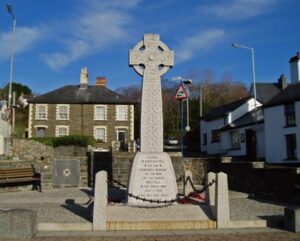
The Great War, 1914-1918
Henry John Ballinger, Second Lieutenant, Monmouthshire Regiment. Henry was the son of John and Amy Amelia Ballinger, of Sherborne House, Aberystwyth. Educated at St. Paul’s School, he enlisted at the outbreak of war into the Royal Welsh Fusiliers. Henry was commissioned on 22 April 1915 into the Monmouthshire Regiment, and went to France on 19 July 1915, where he was posted to the 1st Battalion, Monmouthshire Regiment. The Battalion was attached to 84 Brigade, 28th Division, but on 3 September 1915 joined the 46th (North Midland) Division, as the Divisional Pioneer Battalion. On 13 October 1915, the Division was sent to attack the Hohenzollern Redoubt, at Loos. During the fighting, the Monmouth’s entered the German trenches, and whilst attempting to manoeuvre some captured German machine-guns into position, Henry was shot dead. The position was fought over intensively over the coming days, and as a result Henry has no known grave. He was 19 years old, and is commemorated on the Loos Memorial, France.

George Benjamin, Private, 29118, South Wales Borderers. George was born at Llanbadarn in 1887, the son of Thomas and Margaret Benjamin. The family later resided at Caehaedd, Cwmrhiedol, Goginan, Aberystwyth. George enlisted at Brecon into the South Wales Borderers, and was posted to France early in 1916, where he was posted to the 1st Battalion, South Wales Borderers, which was attached to 3 Brigade, 1st Division. The Division had suffered heavy casualties at Loos in 1915, and in 1916 moved to the Somme. Here it took part in the Battle of Albert, and fought at Bazentin, Pozieres, Flers-Courcelette and Morval. The Division followed the German retreat to the Hindenburg Line in early 1917, before moving to the Flanders Coast during the summer of 1917. George was killed in action here on 13 July 1917. He was 30 years old, and is buried at Coxyde Military Cemetery, Belgium.

Evan Idwal Caine, Private, 57808, Machine Gun Corps. Evan was the son of William and Catherine Caine, of Primrose Hill, Llanbadarn Fawr. He originally enlisted at Aberystwyth into the South Wales Borderers, but was posted to the 68th Machine Gun Company, Machine Gun Corps. The Company was formed at Grantham, Lincolnshire and joined 68 Brigade, 23rd Division on 4 March 1916, before sailing for France. Evan took part in his first major action during the Battle of Messines, when his Company was on the northern edge of the ridge, by the mines at Hill 60 and The Caterpillar. 68 Brigade was to follow up the main assault, and consolidate the positions. Evan was killed during the severe fighting that followed, on 9 June 1917. He was 20 years old, and is buried at Perth Cemetery (China Wall), Belgium.
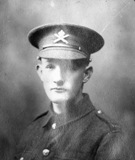
Thomas George Clements, Private, G/50992, Royal Fusiliers. Thomas was born at Kingston-Upon-Thames in 1885, the son of Thomas George Clements, and of Jane Killeen Clements (nee Jenkins). His mother was from Aberystwyth, and his Guardian was Mr. Hugh Hughes, Solicitor, of Aberystwyth. Thomas was Educated at Llandovery College between 1899 and 1903, and at the outbreak of War, was living at Glynpadarn. He enlisted into the Army at Aberystwyth, and joined the 22nd Battalion (Kensington), Royal Fusiliers, which was an ‘elite’ (Public Schoolboy) Battalion, attached to 99 Brigade, 2nd Division. The Division had been on the Western Front since the outbreak of war, and Thomas’s Battalion joined them in November 1915. The Division had just fought at the Battle of Loos, and were near the Hohenzollern Redoubt. In the summer of 1916 the Division were on the Somme, and took part in the Battle of Delville Wood and the Battle of the Ancre, and the ensuing Operations on the Ancre. In March 1917 the Division followed the German Retreat to the Hindenburg Line, and in April they fought at Arras, during the First Battle of the Scarpe, the Battle of Arleux and the Third Battle of the Scarpe. During the fighting at Arras, Thomas was severely wounded and taken prisoner. He was transported to Germany, where he died from his wounds on 12 May 1917. He was 32 years of age, and is buried at Cologne Southern Cemetery, Germany. Photograph courtesy of Michael Bloy.

Alexander Rees Davies, Private, 55547, Royal Welsh Fusiliers. Alexander was born at Llanychaiarn in 1882, the son of Edward and Ellen Davies. He was a plasterer prior to the war, and enlisted at Aberystwyth into the Royal Welsh Fusiliers in 1914. Alexander was posted to France in 1916, joining the 2nd Battalion, Royal Welsh Fusiliers. By then the battalion was attached to 19 Brigade, 33rd Division, which had moved to France during November 1915, and saw its first major action during the Battles of the Somme, from July 1916 onwards. Alexander was wounded on the Somme, and had made his way back home through the chain of Casualty Clearing Stations and hospitals. He died of his wounds on 25 February 1917, aged 34, and is buried at Llanychaiarn (St. Llwchaian) Churchyard.
David Edward Davies, Driver, 730230, Royal Field Artillery. David was born in 1885, son of David and Mary Davies, of Llanbadarn Fawr. He served with A Battery, 267th Brigade, Royal Field Artillery, which was attached to the 53rd (Welsh) Division. Little is known of David’s war, but he would have served with the Division during the campaign in Palestine. He survived the war, but sadly died in hospital in Cairo on 4 December 1918. David was 34 years old, and is buried at Cairo War Memorial Cemetery, Egypt.
Evan Douglas Davies, Private, 15936, South Wales Borderers. Evan was born at Bryncrug, Towyn in 1895, the son of Evan Jones and Lily Davies, of Llanbadarn. Evan enlisted at Aberystwyth into the 8th Battalion, South Wales Borderers. The battalion formed at Brecon in 1914, moving to Seaford in 67 Brigade, 22nd Division, and on 6 September 1915 landed at Boulogne. On 30 October 1915 the Division sailed from Marseilles and arrived Salonika about 12 November 1915, where it remained for the rest of the war. Evan had fought with the battalion since its arrival in France, and had fought throughout the campaign in Salonika. He was killed in action there on 27 July 1918, aged 22, and is buried at Karasouli Military Cemetery, Salonika. His parents later moved to Tyn-y-Coed Gardens, Arthog, Dolgelley, Merioneth.
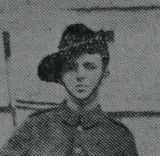
Henry Davies, Private, 48007, West Yorkshire Regiment. Henry was born at Llanbadarn, and enlisted at Hammersmith into the Army Service Corps. He served with their Motor Transport section for a while, before being sent to France in 1916, joining the 18th Battalion, West Yorkshire Regiment. The battalion formed at Bradford, as part of 93 Brigade, 31st Division, and moved to Egypt in December 1915. As the Gallipoli campaign was being closed down, the Division was diverted to France in March 1916, and saw its first major action at the Battle of Albert in July 1916. The Division took part in the assault on Serre, and suffered very high casualties, and was withdrawn for several months as a result, before moving back into the line in November 1916, before taking part in the Battle of the Ancre. The Division wintered on the Ancre, until moving to Arras the following year. Here they fought at the Third Battle of the Scarpe, and helped in the capture of Oppy Wood. Henry was killed in action here on 3 May 1917. He has no known grave, and is commemorated on the Arras Memorial, France.

Jonathan Davies, Pioneer, 129914, Royal Engineers. Jonathan was born in 1890, the son of Eliza Davies, of Carrog Cottage, Llanbadarn. He enlisted at Rhyl on 16 November 1914 into the North Wales Battalion, Royal Welsh Fusiliers, but was subsequently transferred to the Royal Engineers. Jonathan went to France in 1916 attached to a Special Company of the Royal Engineers. The Special Company’s were the chemical warfare specialists of the day, and were tasked with the release of poisonous gas into the German lines prior to infantry attacks. Jonathan suffered due to his work, and in March 1917 began to struggle with his breathing. He was discharged from the army as unfit on 14 June 1917, suffering from tuberculosis, and was sent for treatment at a sanatorium. He died on 19 June 1917 in hospital at Lewisham, and was brought home for burial at Llanbadarn Fawr Cemetery.
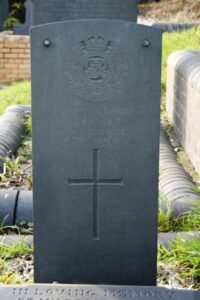
Robert Humphrey Davies, Second Lieutenant, Royal Welsh Fusiliers. Robert was born at Swansea in 1888, the son of the Reverend Evan William and Sarah Davies. Prior to the war he was a Student at Aberystwyth University, where he met and married his wife, Rosa Gwendoline Davies, and the couple set up home at Dolgoed, Elm Tree Avenue, Aberystwyth. Robert originally enlisted into the Royal Engineers, and served in France from 14 September 1915. He was on 19 February 1918 commissioned into the 13th Battalion, Royal Welsh Fusiliers, which was attached to 113 Brigade, 38th (Welsh) Division. He joined the battalion prior to its move from Armentieres to the Somme, where the Division took up positions facing Aveluy Wood, north of Albert. Here they regained some ground in the coming weeks, before settling down for routine trench warfare, until the launching of the great offensive on 21 August 1918. The 13th RWF advanced across the River Ancre over the coming days, and saw heavy fighting. Robert was killed in action here on 23 August 1918. He was 30 years old, and is buried at Bouzincourt Ridge Cemetery, Albert, France.


Thomas Davies, Private, 61573, Royal Army Medical Corps. Thomas was born in 1892, the son of David and Margaret Davies, of Preswylfa, Capel Sion, Llanbadarn. He resided at Porth prior to the war, and enlisted at Tylorstown into the Royal Army Medical Corps. Thomas arrived in Salonika on 15 September 1915, and was then attached to the 11th Battery, 1st Brigade, Royal Field Artillery. Thomas survived almost the whole campaign in Salonika, but took ill and died there on 10 November 1918, the day before the armistice. He was 26 years old, and is buried at Mikra British Cemetery, Kalamaria, Salonika.

Evan David Edwards, Private, 64068, Machine Gun Corps. Evan was born at Tregaron in 1897, the son of Elizabeth Edwards. Elizabeth was widowed by 1911, and lived with Evan at Shop Dyffryn, Llanbadarn. Evan enlisted at Aberystwyth into the South Wales Borderers on 13 December 1915. He went to France on 10 July 1917, where he was posted to the 228th Company, Machine Gun Corps, which was attached to the 39th Division. He joined the Company at Ypres. Evan was only with his new unit for two weeks, before he was wounded. He died of his wounds at Poperinghe on 24 July 1917, aged just 19, and is buried at Gwalia Cemetery, Poperinghe, Belgium.


Edward Hugh Evans, Private, 66040, Cheshire Regiment. Edward was born in 1899, the son of Robert and Elizabeth Evans, of Nantcaerio, Llanbadarn Fawr. He had been educated at the County School, Aberystwyth, before taking up a post as the Assistant Librarian at the National Library of Wales. Edward enlisted at Aberystwyth into the 59th Training Reserve Battalion on 29 December 1916, and was posted to France on 18 January 1918, joining the 1/6th Battalion, Cheshire Regiment. The battalion was attached to 118 Brigade, 39th Division, which was stationed near St. Quentin. On 21 March 1918, the Division was hit by the German Spring Offensive, which swamped the British front line positions. The British were pushed back over the coming days, and Edward would have taken part in terrible fighting. He was killed in action on 26 March 1918, aged just 19, and is commemorated on the Pozières Memorial, France.


George Fletcher, Private, 44467, South Wales Borderers. George was born in Lancashire in 1891, and resided at Llanbadarn prior to the war with his wife, Winifred. George enlisted at Aberystwyth into the Welsh Regiment, but upon being posted to France in 1916 joined the 10th Battalion, South Wales Borderers, which was attached to 115 Brigade, 38th (Welsh) Division. George probably joined the battalion as one of a batch of reinforcements after its ordeals at Mametz Wood in July 1916. After being withdrawn from the Somme, the Division moved via Hebuterne to Ypres, taking up positions along the Canal Bank at Boesinghe. Here it remained over the coming months, until the launch of the Third Battle of Ypres on 31 July 1917. George however was badly wounded in the build up to the offensive. He was evacuated to the Casualty Clearing Station at Proven, where he died of his wounds on 9 June 1917, aged 26. George is buried at Mendinghem Military Cemetery, Belgium. His wife Winifred later remarried, and resided with her new husband at 4, Crynfryn Row, Aberystwyth.


James James, Lance Corporal, 22127, Welsh Regiment. James was born in 1893, the son of Thomas and Sarah James of Llanbadarn. He enlisted at Tonypandy into the 15th Battalion, Welsh Regiment, which was known as the Carmarthen Pals battalion, attached to 114 Brigade, 38th (Welsh) Division. On 2 December 1915 the battalion moved to France, and the entire Division moved to the Fleurbaix sector, where it was initiated into trench warfare. During June 1916 the Division marched south to the Somme, and on 7 July 1916 attacked Mametz Wood. The initial attack failed, and it was three days later, on 10 July, that a fresh attack was mounted. James was killed in Mametz Wood on 11 July 1916. He was 23 years old, and is commemorated on the Thiepval Memorial, France. There is also a memorial to James at Capel Bethel, Cwmerfyn.

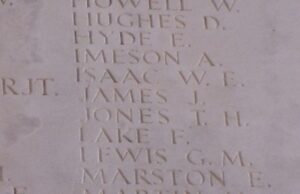
David William Jenkins, Private, 11289, Royal Welsh Fusiliers. David was born at Llanfihangel, Breconshire in 1886, the son of Thomas and Margaret Jenkins. The family had resided at Llanbadarn prior to the war. David enlisted at Brecon into the army, and was posted to France on 11 December 1914, where he joined the 1st Battalion, Royal Welsh Fusiliers, which was at Ypres attached to 22 Brigade, 7th Division. The Battalion had suffered heavy casualties during First Ypres, and were by now in positions near Neuve-Chapelle. In March 1915 the 7th Division fought at the Battle of Neuve Chapelle. During May they fought at the Battle of Aubers Ridge, and at Festubert, before taking part in the Battle of Loos in September. In the summer of 1916, the Division was on the Somme, and took part in the Battle of Albert, capturing Mametz. David was killed on the Somme on 4 July 1916, during the battalions attack on Quadrangle Trench, south of Mametz Wood. He was 20 years old, and is commemorated on the Thiepval Memorial, France.

Arthur Llewellyn Jenkyn, Private, 2030342, Canadian Infantry. Arthur was born at Haslingden on 6 March 1886, the son of Richard Towan and Kate Harper Jenkyn. Arthur was residing with his Grandmother, Ann Jenkyn at Moriah, Llanbadarn by 1901. He emigrated to Canada prior to the war, where he worked as a reporter for the supreme court, and resided with his wife, Sybil Jenkyn, at 1056, Broughton Street, Vancouver, British Columbia. He enlisted at Vancouver on 1 October 1917, and after embarking for France, joined the 72nd Battalion (British Columbia), Canadian Infantry, which was attached to the 12th Brigade, 4th Canadian Division. Arthur joined his battalion south of the River Somme, and would have fought at the Battle of Amiens on 8 August 1918, and the subsequent advance towards the Hindenburg Line. He was killed during the Battle of Drocourt-Quéant, on 4 September 1918. Arthur was 34 years old, and is buried at Ligny-St. Flochel British Cemetery, Averdoingt, France.
Daniel Evan Jones, MM, Private, 3015, Welsh Guards. Daniel was born in 1891, the son of Richard and Margaret E. Jones, Glanyrafon, Llanbadarn Fawr. He enlisted at Aberystwyth into the 1st Battalion, Welsh Guards, which had been raised by Royal Warrant of 26 February 1915, at White City. On 18 August 1915 the Welsh Guards landed at Havre, joining the 3rd Guards Brigade, Guards Division, and saw their first action at the Battle of Loos. Daniel didn’t join the battalion until sometime after the Somme Battles of 1916. He would have fought at the Battle of Pilckem Ridge in August 1917, and at the Battle of Cambrai later that year. The Guards had a hard time at Gouzeaucourt over the winter of 1917-18, but after the launching of the great offensive on 21 August 1918, the Guards took part in the drive towards the Hindenburg Line. Once the Hindenburg Line had been broken, the Allies swept eastwards, and the Guards fought at the Battle of Cambrai, and the Battle of the Selle and the Sambre. Daniel was badly wounded during the fighting around Cambrai, and was evacuated for treatment. He died of his wounds on 14 October 1918, aged 27, and is buried at Delsaux Farm Cemetery, Beugny, France.


Evan Richard Jones, Private, 320242, Welsh Regiment. Evan was born in 1893, the son of Evan J. Jones and Anne Jones, of 3, Spring Gardens, Trefechan, Aberystwyth. He had originally served with the Pembroke Yeomanry. During March 1916 the 1/1st Pembroke Yeomanry moved to Egypt, where it merged with the Welsh Border Mounted Brigade and formed the 4th Dismounted Brigade. On 2 February 1917 it merged with the 1/1st Glamorgan Yeomanry to form the 24th Battalion, Welsh Regiment, and became attached to 231 Brigade, 74th (Yeomanry) Division. The Division had formed in Egypt in January 1917 and had fought through the Palestinian Campaign, at the Battles of Gaza and the Battle and capture of Jerusalem. Evan was killed in action at Beersheba on 6 November 1917. He was 24 years old, and is buried at Beersheba War Cemetery, Israel.
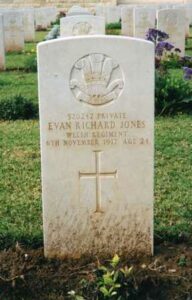
Evan Richard Jones, Private, 18737, Welsh Regiment. Evan was born in 1893, the son of Richard and Ellen Jones, of 2, Prospect Place, Llanbadarn Fawr. He enlisted at Aberystwyth into the 13th Battalion (2nd Rhondda), Welsh Regiment, which was attached to 114 Brigade, 38th (Welsh) Division. On 2 December 1915 the battalion moved to France, and the entire Division moved to the Fleurbaix sector, where it was initiated into trench warfare. During June 1916 the Division marched south to the Somme, and on 7 July 1916 attacked Mametz Wood. The initial attack failed, and it was three days later, on 10 July, that a fresh attack was mounted. After two days of heavy hand to hand fighting within the wood, the Germans withdrew, and the battered Welshmen moved via Hebuterne to Boesinghe, on the Yser Canal. Evan was killed in action here on 13 October 1916. He was 23 years old, and is buried at Essex Farm Cemetery, Belgium.


Henry Morgan Jones, Private, 1380, Welsh Guards. Henry was born at Llanbadarn in 1890, the son of Mary Hughes. Mary later resided at Tancoed, Llanfarian. Henry was a policeman with the Glamorgan Constabulary, and enlisted at Bridgend into the 1st Battalion, Welsh Guards, which had been raised by Royal Warrant of 26 February 1915, at White City. On 18 August 1915 the Welsh Guards landed at Havre, joining the 3rd Guards Brigade, Guards Division, and saw their first action at the Battle of Loos. In the summer of 1916 the Guards moved south to the Somme, where they fought at the Battle of Flers-Courcelette. Henry was killed in action here on 10 September 1916. He was 26 years old, and is buried at London Cemetery and Extension, Longueval, France.

John Emlyn Jones, Driver, 730076, Royal Field Artillery. John was son of John D. and Mary E. Jones, of Tycoch, Bow Street. He had enlisted at Aberystwyth into the 1/1st Cardiganshire Battery, Royal Artillery, and landed in France on 20 November 1915. John served in France for some time, before being posted to the 267th Brigade, Royal Field Artillery, which was attached to the 53rd (Welsh) Division in Egypt. They remained on the Suez Canal Defences for the next twelve months, and in early 1917 moved into Palestine, where they remained for the duration of the war, fighting at the Battles of Gaza, and successfully capturing Jerusalem. John survived the epic campaign in Palestine, but he sadly died whilst still in Egypt on 8 February 1919. John was 29 years old, and is buried at Alexandria (Hadra) War Memorial Cemetery, Egypt.


Thomas Morris Jones, Private, 27433, South Wales Borderers. Thomas was born at Llanbrynmair in 1892, the son of Jonathan and Catherine Anne Jones. He enlisted at Aberystwyth into the army, and was posted to Egypt, to join the 4th Battalion, South Wales Borderers, which was attached to 40 Brigade, 13th (Western) Division. On 12 February 1916 the Division began to move to Mesopotamia, to strengthen the force being assembled for the relief of the besieged garrison at Kut al Amara. By 27 March, the Division had assembled near Sheikh Saad and came under orders of the Tigris Corps, and then took part in the attempts to relieve Kut. However, after these efforts failed and Kut fell, the British force in the theatre was built up and reorganised. The Division then fought at the Battle of Kut al Amara, at the capture of the Hai Salient and the capture of Dahra Bend, before moving on Baghdad. Thomas was killed in action during subsequent clearing up operations, on 29 March 1917. He was 24 years old, and is commemorated on the Basra Memorial, Iraq.
William Thomas Jones, Private, 43819, Welsh Regiment. William was born at Llanbadarn, and enlisted at Maesteg into the Welsh Regiment. He was posted to France in 1916, where he joined the 2nd Battalion, Welsh Regiment, which was attached to 3 Brigade, 1st Division. William would have fought during the Battle of the Somme with the 2nd Welsh. The Division followed the German retreat to the Hindenburg Line in early 1917, moved to the Flanders Coast during the summer of 1917. After the Third Battle of Ypres had stalled in the mire, the Division was recalled to Ypres, and fought at the Second Battle of Passchendaele. After spending another Winter in Flanders, the Division was near Estaires when the German Spring Offensive caught it, fighting through the Battles of Estaires, Hazebrouck, and Bethune. After the launching of the great offensive on the Somme in August 1918, the 1st Division moved south, fighting at the Battle of Drocourt-Queant, and at the Battle of Épehy. William was wounded here, and was evacuated to the Casualty Clearing Station near Harbonnieres, where he died of his wounds on 18 September 1918. William is buried at Heath Cemetery, Harbonnieres, France.

Hugh Lloyd, Lieutenant, King’s African Rifles. Hugh was born in 1890, the son of Edward and Sarah Lloyd, of Parcyllyn, Llanbadarn. He worked in London as a Bank Clerk prior to the war, before enlisting into the Motor Machine Gun Corps. Hugh landed in East Africa on 16 March 1916, probably serving in an armoured car unit, operating against the German forces in East Africa. He was commissioned into the 1st/3rd Battalion, King’s African Rifles on 27 April 1917. Sadly Hugh took ill, and died in Africa on 19 July 1917. He was 27 years old, and is buried at Dar Es Salaam War Cemetery, Tunisia. Many thanks to Harry Fecitt for the photograph.


William Robert Lloyd, Second Lieutenant, Royal Welsh Fusiliers. William was born in 1894, the son of William and Elizabeth Jane Lloyd, of Bronglais, Aberystwyth. He originally enlisted into the Royal Army Medical Corps, but was commissioned into the 15th Battalion, Royal Welsh Fusiliers on 26 June 1917, landing in France on 12 August 1917 to join up with the battalion, which was attached to 115 Brigade, 38th (Welsh) Division. The Division had just had its epic fight at Pilckem Ridge. After being relieved from the Ypres sector, the 38th Division moved back to Armentieres, to rest and rebuild, but in March 1918 moved south to take over the Aveluy Wood sector, north of Albert, on the Somme. Here, William was attached to the 2nd Battalion, Royal Welsh Fusiliers, which had recently joined the Division. On 12 July 1918, the 2nd RWF were tasked with a raid on the German positions at Hamel. After a short barrage, the men went forward into the German lines, and a tremendous fight ensued, but the raid was successful, with 19 prisoners and a machine-gun captured, and over 50 Germans killed. Casualties amongst the 2nd RWF were relatively light, but William had been killed that day, and his remains left in No Man’s Land. He was 24 years old, and is commemorated on the Pozières Memorial, France.


Evan Arthur Morgan, Private, 2624, Guards Machine Gun Regiment. Evan was born at Aberffrwd in 1892, the son of Elizabeth Morgan, of Tanberth. He worked as a Waggoner at a farm in London prior to the war, before enlisting into the Welsh Guards. Evan was posted to the 4th Battalion, Guards Machine Gun Regiment, after its formation on 10 May 1918. The battalion was attached to the famous Guards Division, and was stationed north of the Somme. On 8 August the Australian Corps advanced towards the town of Villers Brettoneux and won a mighty battle there against the Germans, thus turning the war. On 21 August the British launched an attack on the Somme, and the Guards Division fought here at the Battle of Albert, driving eastwards towards Bapaume over the coming days. Evan was killed during the initial advance, on 23 August 1918. He was 26 years old, and is buried at Douchy-Les-Ayette British Cemetery, France.
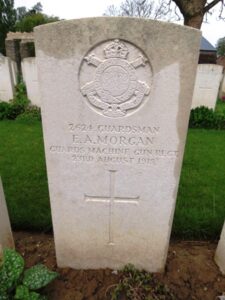
David Owen, Private, 70072, Royal Welsh Fusiliers. David was born in 1892, the son of Richard and Ann Owen, of Gellifadog, Capel Bangor. He enlisted at Aberystwyth into the army, and at some time at the end of 1917 was posted to France, joining the 9th Battalion, Royal Welsh Fusiliers, which was attached to 58 Brigade, 19th (Western) Division. On 21 March 1918 the Division was caught up in the German Spring Offensive north of St. Quentin, suffering terrible casualties during the retreat towards Bapaume. The battered Division moved to Messines to rebuild, but were caught up in the German attack at Messines the following month, fighting a terrible rearguard action over the following days, before being moved to a quieter sector on the Aisne to rebuild. Unfortunately this is where the Germans had decided to launch their last ditch effort to break the Allied lines, and the Division was again caught up in terrible fighting. David was wounded around this time, and after treatment in France returned to hospital in England. David died at Weymouth Hospital after the armistice, on 30 November 1918, aged 26. He is buried at Goginan (Jezreel) Welsh Baptist Chapelyard.
William Henry Kenrick Owen, MID, Lieutenant, Welsh Regiment. William was born on 12 December 1893, the son of William Pierce Owen (Solicitor) and Ethel Owen, of Bodowen, Aberystwyth. He was educated at Aberystwyth Grammar School and Shrewsbury School before being admitted to Clare College Cambridge on 11 October 1913. On 15 August 1914 William applied for a commission into the army, and joined the 9th Battalion, Welsh Regiment, which was attached to 58 Brigade, 19th (Western) Division. William landed in France with the 9th Welsh on 18 July 1915, and moved to positions north of Loos. Here the Division was destined to stage a diversionary attack near Festubert, during the opening the Battle of Loos on 25 September 1915. William was in charge of the battalion scouts, and would have been one of the first out of the trenches when the whistles blew for the 9th Welsh to make their charge. Like many others that day, William was brought down, badly wounded, and was evacuated to the Military Hospital at Rouen. He died of his wounds there on 1 October 1915. William was 21 years old, and is buried at St. Sever Cemetery, Rouen, France.


William Edward George Pryce Wynn Powell, Lieutenant, Welsh Guards. William was born on 8 March 1899, the son of Captain Edward Athelstan Lewis Powell, and Margaret Louisa Powell (née Pryse), of Nanteos, Llanbadarn. He was commissioned into the Welsh Guards, and by the summer of 1918 was in command of King’s Company, 1st Battalion, Welsh Guards, which was attached to the 3rd Brigade, Guards Division. On 8 August the Australian Corps advanced towards the town of Villers Brettoneux and won a mighty battle there against the Germans, thus turning the war. On 21 August the British launched an attack on the Somme, and the Guards Division fought here at the Battle of Albert, and then pushed east towards Bapaume. From here on the Allies had the upper hand, and moved towards the Hindenburg Line, where the Guards Division fought at the Battle of Havrincourt and the Battle of the Canal du Nord. Once the Hindenburg Line had been broken, the Allies swept eastwards over territory that had been occupied by the Germans for four long years. The Guards fought at the Battle of Cambrai, helping drive the Germans back across the Rivers Selle and Sambre in the coming weeks. In one of the last actions fought by the Welsh Guards in the Great War, on 6 November 1918, they had been tasked with capturing the village of Amfroipret, and nearby Bavai. William was killed during the attack on Amfroipret that day. He was originally buried at Buvignies, but his grave was moved after the war to the larger Maubege-Centre-Cemetery, France. There is a Memorial to William at St. Padarns Church and a large one to him at Llanbadarn.


Sir Edward John Webley Parry Pryse (Bart), Major, Welsh Regiment. Edward was born in 1862 at Llanbadarn, the son of Sir Pryor Pryse, of Gogerddan. Edward married Nina Katherina Angharad Webley-Parry, daughter of David Kedgwin William Henry Webley-Parry and Nina Katherina Elena de Palatiano, in 1891. Edward had served in the army for some years prior to the outbreak of the Great War, and volunteered to serve with the 9th Battalion, Welsh Regiment, which was attached to 58 Brigade, 19th (Western) Division. The Division moved to France during July 1915, and moved to positions near Loos, where it took part in the opening attack of the Battle of Loos on 25 September 1915. The following year the Division moved to the Somme, where it took part in the second wave of the attack on Ovillers-La Boiselle on 1 July, capturing the village at heavy cost. It then fought through the Somme Battles of Poziéres and the Ancre in 1916. In 1917 the Division moved north to Ypres, taking part in the Battle of Messines, then the Third Battle of Ypres. In 1918 the Division had a terrible time, being caught up in the three main German attacks that year, on the Somme, on the Lys and on the Aisne. By then, Edward had been invalided home. He died on 20 October 1918, aged 56, and is buried at Penrhyncoch, at Eglwys Sant Ioan. Edward is not commemorated by the CWGC.
David John Pugh, Shoeing Smith, W4981, Royal Field Artillery. David was the son of John and Jane Pugh, of Llanbadarn Fawr. He enlisted at Llanbadarn into the Welsh Artillery in 1914, and after the organisation of the 38th (Welsh) Division, he became a Shoeing Smith with C Battery, 122nd Brigade, Royal Field Artillery, which was attached to the Division. The Division crossed to France in the first week of 1915, and took up positions near Fleurbaix, where it was initiated into trench warfare. Over the coming weeks the Division held every part of the line, from Neuve-Chapelle to Cuinchy. David is recorded as having died in hospital at Bethune on 4 April 1916. He was 31 years old, and is buried at Bethune Town Cemetery, France.


Thomas John Pugh, Lance Corporal, 15955, Welsh Regiment. Thomas was the son of John and Jane Pugh, of Llanbadarn Fawr. He lived at Llanbradach prior to the war and enlisted at Swansea into the 9th Battalion, Welsh Regiment, which was attached to 58 Brigade, 19th (Western) Division. He landed in France with the battalion on 18 July 1915, taking up positions in the Givenchy area. The division took part in a diversionary assault on 25 September 1915 during the Battle of Loos, and suffered terrible casualties. Thomas was badly wounded and evacuated to hospital, and died on 4 October 1915. He is buried in Boulogne Eastern Cemetery, France. He does not appear to be commemorated locally, although he seems to be the brother of David John Pugh, above.

Roderick Alexander William Pryse Richardes, Second Lieutenant, Royal Welsh Fusiliers. Roderick was born at Llanbadarn on 27 September 1898, the son of Roderick Clement Richardes and Edith Mary Richardes, of Penglais, Aberystwyth. Roderick was commissioned into the 1st Battalion, Royal Welsh Fusiliers on 20 December 1917, but instead of embarking for France was sent to join the 11th Battalion, Royal Welsh Fusiliers in Salonika. The battalion was attached to 67 Brigade, 22nd Division, and was preparing for its final offensive of the war when Roderick joined the battalion on 21 June 1918. On 18 September 1918 the Allies launched the Third Battle of Doiran, and assaulted the Bulgarian positions around Lake Doiran. Roderick was reported to have been wounded and taken prisoner by the Bulgarians, but no more trace of him was ever found. He is officially recorded as having been killed in action during the charge on the Bulgarian trenches that day. He was 19 years old, and is commemorated on the Doiran Memorial, Salonika.

John Richards, Private, G41718, Middlesex Regiment. John was born at Llanbadarn in 1891, the son of Thomas and Mary Anne Richards. Prior to the Great War, the family resided at 62, New Compton Street, Charing Cross, London, where they ran their own dairy business. John enlisted at Holborn, Middlesex into the Welsh Horse Yeomanry, but didn’t embark for Gallipoli with them, instead he was one of a batch of men transferred to the 20th Battalion, Middlesex Regiment. The battalion was attached to 121 Brigade, 40th (Bantam) Division, and moved to France during the first week of June 1916, taking up positions near Loos. Late in 1916 they moved south to the Somme, and fought at the Battle of the Ancre, and remained in the area over the winter. In March 1917 the Germans withdrew to their shortened line, called the Hindenburg Line, and the 40th Division were one of the Divisions that followed the withdrawal. Later in the year they took part in the Battle of Cambrai, playing an important role in the attack on Bourlon Wood. John was killed in action at Bourlon Wood on 24 November 1917, aged 26. He is commemorated on the Cambrai Memorial, Louverval, France.

David Morris Scott, Engine Room Artificer 1st Class, 65/EC, Royal Naval Reserve. David was born at Llanbadarn on 12 November 1881, the son of Gavin and Sarah Lizzie Scott, of Llanychaiarn. He served with the Royal Navy aboard the requisitioned merchant ship HMS Cyclops. David survived the war, but died at Carmarthen Hospital on 28 January 1920, aged 38. He is buried in Llanychaiarn (St. Llwchaian) Churchyard. David does not appear to be commemorated locally.
David Morgan Stephens, Private, G33866, Middlesex Regiment. David was born at Llanbadarn in 1895, the son of James and Elizabeth Stephens. David had worked as a carpenter with his father prior to the war, but at some time had moved to Middlesex to work. He enlisted there into the Middlesex Regiment, and was posted to France in 1916, joining the 1st Battalion, Middlesex Regiment, which was by then attached to 98 Brigade, 33rd Division. The Division moved to France during November 1915, and saw its first major action during the Battles of the Somme, from July 1916 onwards. They then fought at the Battle of the Scarpe and at Bullecourt, before heading to Ypres, and fighting at the Menin Road and at Polygon Wood. David was killed in action at Polygon Wood on 24 September 1917. He was 22 years old, and is today buried at Tyne Cot Military Cemetery, Belgium.

William David Stephens, Gunner, 156560, Royal Garrison Artillery. William was born at Llanbadarn in 1887, the son of W. and S. Stephens, of Aberystwyth. He married in 1910, and by 1911 had moved to Harcourt Street, London with his wife Elizabeth, where he worked as a dairyman. William enlisted at Hammersmith into the Royal Artillery, and was posted to France with 265th Siege Battery, Royal Garrison Artillery, which had formed at Hartlepool on 28 September 1916. By the summer of 1917 the Battery had moved to Ypres, where it supported the Allied assault during the Third Battle of Ypres. William was wounded here, probably by German counter-battery fire, and died of his wounds on 15 September 1917. He was 30 years old, and is buried at The Huts Cemetery, Belgium. His bereaved widow, Elizabeth, moved back to 56, Terrace Road, Aberystwyth.


Horace James Talbert, Lance Corporal, 47172, Welsh Regiment. Horace was born in 1896, the son of Robert and Elizabeth Talbert, of Primrose Hill, Llanbadarn Fawr. By 1911 he was residing at Bristol with his Uncle, David Jones, a Bass Player, who was teaching his nephew his musical skills. Horace enlisted at Bristol into the Royal Welsh Fusiliers, but was posted to the 11th Battalion (Cardiff), Welsh Regiment, which was in Salonika attached to 67 Brigade, 22nd Division. On 18 September 1918 the Allies launched the Third Battle of Doiran, and assaulted the Bulgarian positions around Lake Doiran. Horace was killed in action here, during terrible hand to hand fighting in the Bulgarian trenches. He was 21 years old, and is commemorated on the Doiran Memorial, Salonika.

Joseph Thomas, DCM, MM, Sergeant, 3238, Royal Scots. Joseph was born in 1888, the son of John and Elizabeth Thomas, of Llanbadarn. He married Christina Yeardly prior to the war, and lived with her at Cardigan. Joseph was an army reservist, and at the outbreak of war rejoined the 2nd Battalion, Royal Scots at Fife. He landed in France with the battalion on 23 October 1914, attached to 8 Brigade, 3rd Division. The Division moved to the Belgian frontier, and fought during the opening Battle of Mons and in the retreat, to the Marne, where the German Offensive was stopped, before fighting at the Battle of the Aisne. The Division then moved north to Flanders, and took part in the Battle of La Bassée, and at the Battle of Messines, which were a prelude to the First Battle of Ypres. They took part in the famous Christmas Truce on 25 December 1914 and remained at Ypres throughout the winter. In 1915 the Division saw action at Bellewaarde and Hooge, and took part in the Second attack on Bellewaarde, and in 1916 fought at the Actions of the Bluff, and at the St Eloi Craters. Joseph was awarded the Distinguished Conduct Medal for his gallantry at Ypres. He took ill during this time, and returned to Llanbadarn to recuperate. He was back in France on 13 April 1916, whereupon he joined the 12th Battalion, Royal Scots, which was attached to 27 Brigade, 9th (Scottish) Division. Joseph saw heavy fighting on the Somme that year, which was to gain him the award of the Military Medal. By April 1917 the Division had moved to Arras, and it was there, during the Battle of the Scarpe, that Joseph was killed, on 12 April 1917. He was 29 years old, and is buried at Brown’s Copse Cemetery, Rouex, France. (Please see the Ceredigion Heroes page for further details of Joseph’s awards). His widow Christina later remarried, and resided with her new husband at Grangehill Farm, Kinghorn, Fife.


John Parry Williams, Third Engineer, Mercantile Marine. John was born at Llanrhystud in 1894, the son of John Thomas and Jane Williams (nee Parry). The family later resided at the Post Office, New Cross, Aberystwyth. John was an iron worker prior to the war, before becoming an engineer with the Mercantile Marine, serving aboard the SS Argyll, a Newport registered Turret Hull steamship. ON 13 April 1917, Argyll was on route from Port Kelah for Middlesbrough with a cargo of iron ore, when she was torpedoed and sunk by the German submarine U-84. John was among 22 men killed in her sinking. He was 23 years old, and is commemorated on the Tower Hill Memorial, London.
World War Two, 1939-1945
David Michael Dalton, Lieutenant, 117786, Royal Artillery. David was the son of Joseph Benton and Elinor Dalton, of Brook House, Llangawsai, Aberystwyth. He served with 408 Battery, 146 (The Pembroke Yeomanry) Field Regiment, Royal Artillery. The 146th Field Regiment was raised in Cardiganshire, and joined the Eighth Army in time to take part in the Battle of El Alamein. Afterwards it became part of the 7th Armoured Division, taking part in the advance to Tripoli, and helping defeat Rommel’s counter-attack at Medenine. The Regiment fought with the Desert Rats until the fall of Tunis in May 1943. It landed on the beaches of Salerno, taking part in the crossing of the Volturno and the bitter fighting for Monte Camino. David was killed in Italy on 9 October 1943. He was 24 years old and is buried at Naples War Cemetery, Italy.
Hugh Morris Davies, Gunner, 925853, Royal Artillery. Hugh was the son of Morgan and Elizabeth Anne Davies, of Llanbadarn. He served with 146 (The Pembroke Yeomanry) Field Regiment, Royal Artillery. The 146th Field Regiment was raised in Cardiganshire, and joined the Eighth Army in time to take part in the Battle of El Alamein. Afterwards it became part of the 7th Armoured Division, taking part in the advance to Tripoli, and helping defeat Rommel’s counter-attack at Medenine. Hugh was killed in North Africa on 6 March 1943. He was 20 years old, and is buried at Sfax War Cemetery, Tunisia.
Herbert Stanley Greenhead, Aircraftman 1st Class, 1033919, Royal Air Force Volunteer Reserve. Herbert was born at Hull in 1909, the son of Henry and Anne Greenhead. He married his cousin Marjorie Violet Greenhead in 1933, and the couple moved to Llanbadarn Fawr. Herbert served during the war with the Royal Air Force. Herbert died at the Three Counties Hospital, Stotford on 6 May 1944, aged 35, and was cremated at Golders Green Crematorium, Middlesex. Herbert is not commemorated at Llanbadarn.
William Robert James, Gunner, 5124665, Royal Artillery. William was born at Llanbadarn, the son of William and Emma May James. The family later resided at Oswestry, Shropshire. William served with 178 Field Regiment, Royal Artillery. He fought in the Far East during the war, fighting against the Japanese. William survived the war, but died at Jakarta on 12 February 1946. He was 21 years old, and is buried at Jakarta War Cemetery, Indonesia. The photograph is courtesy of Tony Beck.
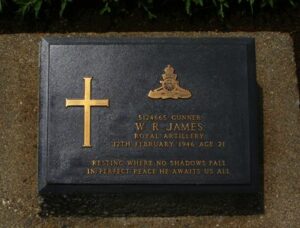
Richard George Read, Captain, 93818, Royal Artillery. Richard was born on 28 April 1899, the son of George and Mary Read. Richard joined the Royal Horse Artillery as a boy aged 14 and served with the BEF in France during WW1, and later Palestine and Egypt after WW1, he remained in the Royal Horse Artillery until 1936, marrying Daisy Marion Preston in 1927 whilst stationed in Cairo, Egypt. Richard and Daisy then lived at Broadway, Llangawsai, Aberystwyth. Shortly following his retirement from the army after over 21 years in the colours, he re-enlisted just before WW2 and joined the Royal Artillery again. Richard was captured whilst serving with the 118th Field Regiment Royal Artillery at the fall of Singapore in February 1942, spending the rest of the War as a POW of the Japanese. He survived and returned to Aberystwyth in December 1945 after time convalescing in India. His health suffered during his time in captivity and he sadly died at Chester Military Hospital on 11 September 1946, aged 47. He is buried at Plumstead Cemetery, London.


William Henry Ward, Gunner, 891226, Royal Artillery. William was the son of Mr. and Mrs. T. A. Ward, of Llanbadarn. He served with 146 (The Pembroke Yeomanry) Field Regiment, Royal Artillery. The 146th Field Regiment was raised in Cardiganshire, and joined the Eighth Army in time to take part in the Battle of El Alamein. Afterwards it became part of the 7th Armoured Division, taking part in the advance to Tripoli, and helping defeat Rommel’s counter-attack at Medenine. William was killed in North Africa on 28 March 1943. He was 27 years old, and is buried at Sfax War Cemetery, Tunisia.
James Warrell Williams, Sergeant, 1285053, Royal Air Force Volunteer Reserve. James was the son of James Warrell Williams and Louisa Williams, of Llanbadarn, and the husband of Rosina Jane Williams, of Newbiggin-by-Sea, Northumberland. He served with 101 Squadron, Royal Air Force. James was killed in action on 20 June 1942, aged 21, and is commemorated on the Runnymede Memorial, Surrey.
Pryse Wilson Williams, Rifleman, 4201794, Royal Ulster Rifles. Pryse was the son of David Morris Williams and Catherine Williams of Llanbadarn. He served with the 30th Battalion, Royal Ulster Rifles. Pryse was on home service when he died on 5 July 1943, aged 23. He is buried at Staylittle Baptist Chapelyard, England. Pryse is not commemorated on the main Llanbadarn memorial.